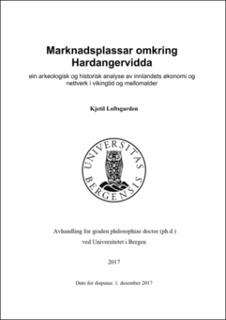| dc.description.abstract | The period from the late Viking Age to the High Middle Ages, c. 950–1350, was an era of economic expansion, where towns were formed, populations increased, and royal and church power were established. This thesis examines the inland regions of Southern Norway and the exchange of commodities at marketplaces between the mountainous and valley districts and the coastal areas in this period. The marketplaces are seen as part of a larger economic whole, including specialized surplus production, the trading of this surplus, and the overall impact this had on society. Central questions are how can the marketplaces be identified, where were they located, when were they used and who were involved in the exchange at the marketplaces? I see the marketplaces in conjunction with the surplus production of outfield resources and explore issues such as; who were the actors behind the surplus production from outfield resources and the subsequent trade with these commodities? The theme of the thesis is extensive; geographically, thematically and chronologically. The focus is therefore on the overall structure of the utilization of outfield resources and trade between mountainous and coastal areas. The thesis is thus developed in line with an understanding of time and change where long overarching structures are slowly changing through interaction with events with a shorter time span. Topographical and climatic factors, such as limited arable land but large outfield areas, provided limitations and opportunities for the people living in the mountainous and valley districts, and this can be seen as an overall structure which required a degree of regional specialization based on traditions and different natural conditions. Several archaeological surveys and a re-examination of existing archaeological and historical material have shown the existence of a broad range of marketplaces, from seasonal marketplaces in mountainous regions to more established marketplaces with an urban character in inner fjord regions. In collaboration with Norwegian Institute for Cultural Heritage Research (NIKU), an area in Kinsarvik by the Hardangerfjord was mapped using groundpenetrating radar. This and previous surveys show traces of 18–20 buildings which most likely should be connected to crafts and trade in Kinsarvik in the early and High Middle Ages. Similarly, surveys conducted on probable marketplaces in mountainous regions found traces of tent rings, horseshoes, horseshoe nails, fire steel and knives that could be traces of yearly gatherings for the purpose of trade, competitions and social interaction. It is an aim of this thesis to see the marketplaces in a wider context in relation to the exploitation of resources, routes and administrative regions. To achieve this goal, and to aid in the analysis of the material, I have used Geographic Information Systems (GIS). By storing both spatial and non-spatial data in a geodatabase I have analysed archaeological data in conjunction with historical sources, place names and topographical elements. In addition, I have re-calibrated and applied a statistical analysis to earlier C-14-results and made calculations regarding the total amount of iron produced in the late Viking Age–High Middle Ages. The results indicate that iron production, hunting, and trapping was organized and carried out by local farmers, and that goods from this surplus production were exchanged at seasonal marketplaces in the mountainous or upper valley districts, or at more permanent marketplaces like Kinsarvik in Hardanger or Kaupanger in Sogn. Furthermore, my analysis shows that the iron production in the south Norwegian inland was on a massive scale in this period and seems to exceed both regional and national demands for iron. This indicates that iron not only constituted a necessary item for regions with little iron production, such as the coastal areas of eastern Norway and large parts of western Norway, but was most likely also an important export article, especially towards Denmark. My contribution to knowledge is that from the late Viking Age there was an interaction between the marketplaces and surplus production in the inland of Southern Norway. The marketplaces can be seen as a contributing factor in the extensive iron production and surplus production from hunting and trapping. Stable economic networks and marketplaces that are emerging in the late Viking Age made it possible for largely autonomous farmsteads around the inland plateau of Hardangervidda to invest in surplus production, since they could rely on this surplus being exchanged for commodities they needed or wanted. The marketplace was also a way to avoid the strict social norms related to trade. By being a dedicated arena for exchange, trade could be carried out in a place where the roles were set and it was less likely for misunderstandings to occur. At the marketplace, an inland population could obtain the products they needed or wanted and the populous communities along the coast – the medieval towns, the royal and ecclesiastical and other elites – had access to the resources from the hinterland via trade networks flowing to these marketplace hubs. I argue that the people in mountainous and valley regions around Hardangervidda took part in both surplus production from outfield resources and the subsequent trade at marketplaces, and the elite to a large part gained access to these important inland resources through trade networks and via marketplaces. However, changes in administrative borders and several law amendments in 13th and 14th centuries indicate a new strategy of linking inland resources more directly to the towns. This thesis gives new insight regarding the extent and consequences of the marketplaces in the south Norwegian inland in the late Viking Age–High Middle Ages. Marketplaces in this period had a social significance for the inland population, but were also of great economic importance for inland regions as well as for society at large. | en_US |
